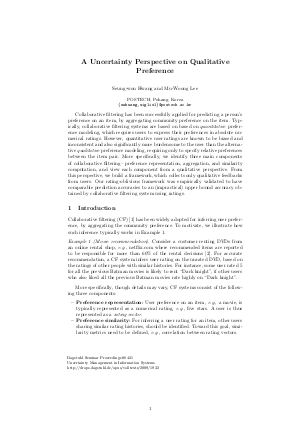A Uncertainty Perspective on Qualitative Preference
Authors Seung-won Hwang, Mu-Woong Lee
-
Part of:
Volume:
Dagstuhl Seminar Proceedings, Volume 8421
Part of: Series: Dagstuhl Seminar Proceedings (DagSemProc) - License:
 Creative Commons Attribution 4.0 International license
Creative Commons Attribution 4.0 International license
- Publication Date: 2009-03-24
File

PDF
DagSemProc.08421.9.pdf
- Filesize: 174 kB
- 9 pages
Document Identifiers
Subject Classification
Keywords
- Collaborative filtering
- qualitative preference
- uncertainty
Metrics
- Access Statistics
-
Total Accesses (updated on a weekly basis)
0Document
0Metadata
Abstract
Collaborative filtering has been successfully applied for predicting a person's preference on an item, by aggregating community preference on the item. Typically, collaborative filtering systems are based on based on quantitative preference modeling, which requires users to express their preferences in absolute numerical ratings. However, quantitative user ratings are known to be biased and inconsistent and also significantly more burdensome to the user than the alternative qualitative preference modeling, requiring only to specify relative preferences between the item pair. More specifically, we identify three main components of collaborative filtering-- preference representation, aggregation, and similarity computation, and view each component from a qualitative perspective. From this perspective, we build a framework, which collects only qualitative feedbacks from users. Our rating-oblivious framework was empirically validated to have comparable prediction accuracies to an (impractical) upper bound accuracy obtained by collaborative filtering system using ratings.
Cite As Get BibTex
Seung-won Hwang and Mu-Woong Lee. A Uncertainty Perspective on Qualitative Preference. In Uncertainty Management in Information Systems. Dagstuhl Seminar Proceedings, Volume 8421, pp. 1-9, Schloss Dagstuhl – Leibniz-Zentrum für Informatik (2009)
https://doi.org/10.4230/DagSemProc.08421.9
BibTex
@InProceedings{hwang_et_al:DagSemProc.08421.9,
author = {Hwang, Seung-won and Lee, Mu-Woong},
title = {{A Uncertainty Perspective on Qualitative Preference}},
booktitle = {Uncertainty Management in Information Systems},
pages = {1--9},
series = {Dagstuhl Seminar Proceedings (DagSemProc)},
ISSN = {1862-4405},
year = {2009},
volume = {8421},
editor = {Christoph Koch and Birgitta K\"{o}nig-Ries and Volker Markl and Maurice van Keulen},
publisher = {Schloss Dagstuhl -- Leibniz-Zentrum f{\"u}r Informatik},
address = {Dagstuhl, Germany},
URL = {https://drops.dagstuhl.de/entities/document/10.4230/DagSemProc.08421.9},
URN = {urn:nbn:de:0030-drops-19323},
doi = {10.4230/DagSemProc.08421.9},
annote = {Keywords: Collaborative filtering, qualitative preference, uncertainty}
}
